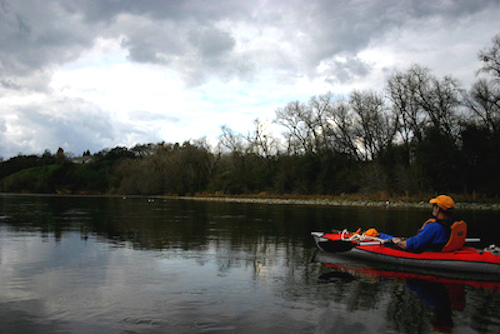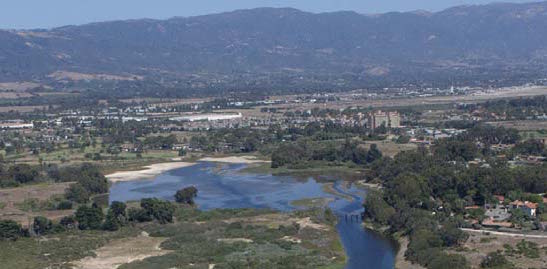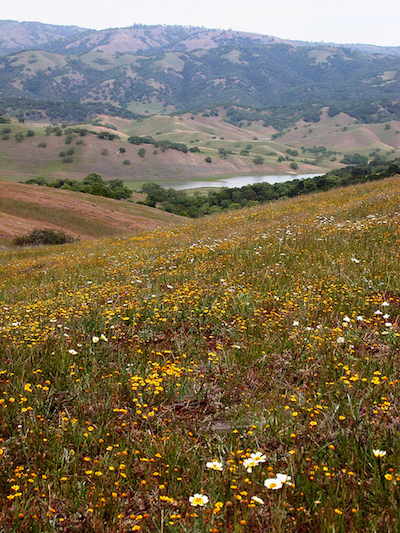Ecosystem Services and Climate Change
 The Sacramento River and riparian forests. Rivers and their floodplain processes are lifelines for people and native species. Outdoor recreation is an ecosystem service important for a healthy society. Photo by Dan Cox/USFWS. |
Ecosystem services are the benefits derived from natural ecosystems by human populations.
|
These benefits have been reduced through land use conversion, water diversion, and pollution. The Millennium Ecosystem Assessment (WRI, 2005) was the first major report that set out to both identify global ecosystem services, and assess how factors such as human encroachment have impacted ecosystem productivity. California's remaining ecosystems are vulnerable to the impacts of a changing climate. Staudinger et al. 2012 analyzed how climate change may alter the provisioning of ecosystem services on a national level in Chapter 4 of their report, while Gardali et al. 2011 and Shaw et al. 2011 provided insight into how climate change will impact ecosystem services and habitats throughout California. Liu 2016 provides a conceptual framework to link ecosystem services with water, energy, and food issues in California in the face of climate change.
Climate Change Resiliency, Ecosystem Services, and Conservation of California's Habitats
Land management agencies and programs have become increasingly aware of the value of "multi-benefit" projects-- investment of limited financial resources into nature-based solutions that address multiple needs of both human and natural communities by restoring the ecosystem services provided by natural habitats and processes. The Federal Resource Management and Ecosystem Services Guidebook features an introduction to the implementation of ecosystem service-focused conservation. The restoration of ecosystems and the consequential enhancement of the services they provide is an essential step to establishing a more climate change-resilient future for California.
| Right: Wetlands and estuaries like Devereux Slough, a coastal estuary in Santa Barbara, provide multiple benefits that serve to buffer the impacts of climate change for human communities and native species. Read more about restoration work being done here and in other coastal wetlands by the Southern California Wetlands Recovery Project. Photo by USFWS. |
 |
Tidal Marshes and Wetlands
Tidal marshes are dynamic ecosystems located along California’s coast that maintain stable shore banks, improve water quality, store carbon, and provide critical wildlife habitat. There are several vulnerability analyses available for coastal ecosystems including: Hutto et al. 2015, which identifies vulnerabilities of the habitats, species, and ecosystem services located along the North-central Coast, and Ackerly et al. 2012 and Ekstrom et al. 2012, who describe projected changes and vulnerabilities in coastal ecosystem services in the San Francisco Bay Area. Appropriate sediment availability is essential for proper ecosystem function. Apitz 2011 describes the role that sediment plays in sustaining aquatic and terrestrial ecosystem services, while providing a framework for creating sediment-ecosystem regional assessments (SEcoRA).
Current relevant CA LCC projects include: "North-Central California Coast and Ocean Climate-Smart Adaptation Project", which is working to provide the resources needed to develop appropriate management options for coastal ecosystem and has produced this "Climate Change Vulnerability Assessment for the North-central California Coast and Ocean", “Incorporating Climate-Smart Adaptive Strategies into Wetlands Recovery in Coastal Southern California”, which aims to provide managers with a way to assess climate change-related wetland vulnerabilities and develop management/conservation priorities in wetlands along the coast of Southern California, and “Structured-Decision Making for Climate Change Adaptation to Conserve San Francisco Bay Tidal Marsh Ecosystems”, which aides managers in selecting the most appropriate conservation strategies that will garner the greatest expected conservation benefits and enhance tidal marsh ecosystem integrity and services. The EPA's “River Corridor and Wetland Restoration” page offers more information about wetlands, restoration projects, and restoration benefits.
 The open space of Coyote Valley, Santa Clara County. Photo by Mike Thomas/USFWS. |
Rangelands and Farmlands
Pollination is an essential ecosystem service that is under pressure from several anthropogenic impacts including land-use and climate change, disease, and insecticides (Vanbergen 2013; Potts et al. 2010). Ongoing pollinator declines have led to a subsequent research that investigates these threats. Kremen et al. 2004 consider the habitat requirements for pollination on farms, adding to these findings in Kremen et al. 2007, where the impact of land use changes on pollinators is examined. Anthropogenic threats to pollinators and food security are also assessed in Chagnon et al. 2014, who study fertilizer-induced risks to a number of ecosystem services. Rangelands provide critical habitat for pollinators, making them an essential ecosystem for sustaining wild pollinator populations. The value of this relationship for California, a state with a thriving agricultural economy, is examined in Chaplin-Kramer et al. 2011. |
The “Threat Assessment on California Rangelands” project investigated how future climate and land use changes may impact the availability of the ecosystem services provided by rangelands. This project includes useful maps and datasets for visualizing changes in carbon sequestration capacity habitat, and water availability based on several climatic projections. A synopsis of the findings is presented in Byrd et al. 2015.
The California Department of Food and Agriculture hosts the “Ecosystem Services Database” which is an interactive website that allows the user to retrieve a list of ecosystem services provided by California’s farms and rangelands based on crop type, county, ecosystem service provided, or keyword. The “Pollinator Conservation Resources” page, created by the Xerces Society for Invertebrate Conservation, offers information about conserving pollinators, including conservation guides, pollinator plant recommendations, and guides for identifying different pollinators. Additional information about rangeland ecosystem services, relevant sources, and decision making support tools can be found on the following website.
Forests
As the climate changes, the sustainability of California’s forests is placed under pressure from global temperature increases (McDowell and Allen 2015), wildfire (van Mantgem et al. 2013), decreased water availability (Williams et al. 2013) and disease (Kliejunas et al. 2009, Kliejunas 2010). There is concern over how these threats will influence the provisioning of essential forest ecosystem services.
Many studies focus on how forests may be utilized for carbon sequestration including: Hurteau at al. 2014, who analyze how changes in climate and management practices will influence future forest carbon stocks in the Sierra Nevadas, Hudiberg et al. 2009, who aim to improve understanding of the many factors that influence forest carbon sequestration, and Nowak et al. 2013, focused on quantifying tree carbon storage in urban forests in the United States. A large portion of California’s water originates in national forest lands, making this ecosystem paramount in a water-limited climate. Podolak et al. 2015 highlight the use of forest restoration as a nature-based solution that can improve water supply in watersheds in the Sierra Nevadas.
There are several useful resources available that are geared towards understanding and managing forests and the services they provide as the climate changes. The California’s Forests and Rangelands: 2010 Assessment identifies threats, assets, and priority landscapes across California, and provides various resources for conservation practices. The CA LCC project “Vulnerability Assessment and Adaptation Strategies for Focal Resources of the Sierra Nevada” identifies vulnerable species populations, ecosystems and ecosystem services in the Sierras. The US Forest Service hosts a website dedicated to assisting landowners in achieving their forest management goals via the forest stewardship approach.
Riparian Areas
Riparian ecosystems connect the aquatic habitat with the terrestrial. Soman et al. 2007 and Machtinger et al. 2007 give an excellent analysis of the ecosystem services provided by riparian habitats. Restoration of these ecosystems could prove to be beneficial for both humans and wildlife alike, leading some to believe that they are essential for preparing other ecological systems for future climatic changes (Seavy et al. 2009). Matzek et al. 2015 also point out that riparian restoration could be financially profitable on the carbon market, adding a further incentive for habitat conservation. Chang and Bonnette 2016 look at the impact of drought in California on a variety of water-related ecosystem services, including impacts on riparian areas.
The River Partners website contains information and resources that center on riparian restoration, some particularly useful sources are the “Reports & Articles” page and the Riparian Habitat Restoration Guidebook (2009). The Climate Smart Conservation Toolkit for riparian habitats created by Point Blue Conservation Science may also prove useful when considering a riparian restoration project. The Riparian Zone Estimation Tool is a decision support tool that estimates functional riparian width based on hillslope, vegetation, and hydrologic connectivity.
Meadows
There are many benefits to be gained from restoring meadow ecosystems. Henry et al. 2011 describe how meadow restoration can be used in fisheries conservation. The CA LCC project, Managing Sierra Nevada Meadows for Water Supply & Habitat Benefits, aims to capture data showing how meadow restoration increases the hydrological benefits of meadow ecosystems, such as summer stream base flow. Viers et al. 2013 analyze how climate change alters the hydrology of the meadow ecosystem while providing managers with guidance on selecting restoration and conservation options.
The Guide for Restoring Functionality to Mountain Meadows of the Sierra Nevada (2012) is a useful tool for planning meadow restoration that includes information about functional meadows, planning strategies, and restoration/management actions.
Click on the subject tag below for a list of resources about ecosystem services and climate change.
10/2017
